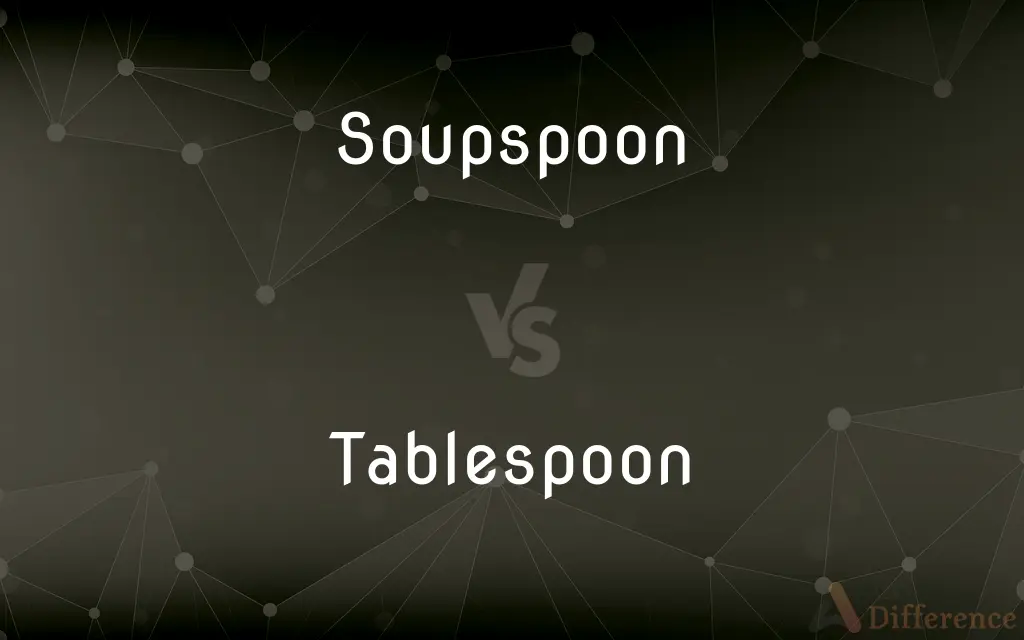Soupspoon vs. Tablespoon — What's the Difference?
By Fiza Rafique & Urooj Arif — Updated on April 2, 2024
A soupspoon is designed for eating liquid foods with its rounded bowl, while a tablespoon is a measurement tool and also a larger spoon used for serving.

Difference Between Soupspoon and Tablespoon
Table of Contents
ADVERTISEMENT
Key Differences
Soupspoons are specifically crafted for consuming soups and broths, featuring a rounded, broad bowl that makes it easier to scoop up liquids. In contrast, tablespoons serve a dual purpose: they are used as a measurement unit in cooking, equivalent to three teaspoons or about 15 milliliters, and as larger serving spoons in dining settings, with a design that’s more versatile for serving various types of dishes.
The design of a soupspoon, with its larger and more circular bowl, is optimized for comfort and efficiency in eating soups, ensuring that liquid food can be easily sipped without spillage. On the other hand, the tablespoon, while larger than a teaspoon, has a design that is not specifically tailored for any one type of food but is rather intended for serving and measuring purposes.
In table settings, soupspoons are often provided alongside other cutlery when soup is served as part of a meal. Tablespoons, however, might not be part of an individual's place setting but rather placed with serving dishes for distributing food onto plates or in specific recipes for measuring ingredients.
Soupspoons can vary in size and design based on cultural preferences; for example, Asian soupspoons are often flat-bottomed with a short handle. Tablespoons, especially when used as a measure, have a more standardized size internationally to ensure consistency in recipes, though serving tablespoons can vary more in design.
While both soupspoons and tablespoons are essential in dining and cooking, their primary functions differ significantly: soupspoons enhance the eating experience for liquid foods, while tablespoons are indispensable for both serving and ensuring precision in culinary measurements.
ADVERTISEMENT
Comparison Chart
Primary Use
Eating soups and broths
Serving food and measuring ingredients
Design
Rounded, broad bowl
Larger than a teaspoon, designed for versatility
Function
Optimized for sipping liquids
Dual-purpose: serving and precise measuring
Place Setting
Part of individual cutlery when soup is served
Often found with serving dishes or used in cooking
Cultural Variations
Design varies by cultural dining preferences
Standardized size for measuring, design varies for serving
Compare with Definitions
Soupspoon
Designed for liquids.
He used a soupspoon to enjoy the broth.
Tablespoon
Dual-purpose tool.
She measured the sugar with a tablespoon.
Soupspoon
Part of dining cutlery.
A soupspoon was set for each diner.
Tablespoon
Standardized for recipes.
The recipe called for 2 tablespoons of oil.
Soupspoon
Enhances soup eating.
The soupspoon made sipping the hot soup easier.
Tablespoon
Larger serving spoon.
The chef used a tablespoon to serve the rice.
Soupspoon
Varied by culture.
Asian soupspoons differ from Western designs.
Tablespoon
Not specific to any food.
Tablespoons can serve both solids and liquids.
Soupspoon
Rounded bowl.
The soupspoon's rounded bowl is perfect for soup.
Tablespoon
Essential in cooking.
A tablespoon is crucial for precise measurements.
Soupspoon
A spoon for eating soup, typically smaller than a tablespoon and larger than a dessertspoon, characterised by having a round bowl rather than the usual oval bowl of other types of spoon.
Tablespoon
A tablespoon is a large spoon. In many English-speaking regions, the term now refers to a large spoon used for serving; however, in some regions, it is the largest type of spoon used for eating.
Soupspoon
A soupspoonful.
Tablespoon
A large spoon for serving food.
Soupspoon
A spoon with a rounded bowl for eating soup
Tablespoon
Abbr. T or tbs. or tbsp. A household cooking measure equal to 3 teaspoons, or 1/2 fluid ounce (15 milliliters). See Table at measurement.
Soupspoon
A spoon somewhat larger than a teaspoon, used for eating soup.
Tablespoon
A large spoon, used for eating food from a bowl.
Tablespoon
A spoon too large for eating, usually used for cooking or serving.
Tablespoon
(cooking) A unit of volume, the value of which varies regionally; in the US: three teaspoons or one half fluid ounce or roughly 15 ml; in Britain and Canada: exactly 15 ml; in Russia 18 ml; in Australia: four teaspoons or 20 ml.
Tablespoon
A spoon of the largest size commonly used at the table; - distinguished from teaspoon, dessert spoon, etc.
Tablespoon
As much as a tablespoon will hold
Tablespoon
A spoon larger than a dessert spoon; used for serving
Common Curiosities
Is there a difference in the size of a soupspoon and a tablespoon?
Yes, soupspoons typically have a larger, more rounded bowl compared to the more versatile and slightly flatter design of a tablespoon.
Can a tablespoon be used for serving all types of dishes?
Yes, tablespoons are versatile serving utensils suitable for a wide range of dishes, from solids like vegetables and rice to liquids like gravy.
How do you measure ingredients using a tablespoon?
Ingredients are measured by filling the tablespoon to the top edge, ensuring a precise volume for recipes.
Are soupspoons and tablespoons made from specific materials?
Both are typically made from materials like stainless steel, silver, or plastic, depending on their use and setting.
Are tablespoons used internationally for measuring?
Yes, tablespoons are used internationally as a standard measurement in cooking, but the exact volume can vary slightly by country.
Can a tablespoon affect the taste of a dish?
While the tablespoon itself doesn't affect taste, accurate measurement of ingredients with it can ensure a dish's intended flavor.
Why might a soupspoon not be suitable for measuring ingredients?
Soupspoons, due to their varied sizes and shapes, lack the standardization required for accurate culinary measurements.
Can you use a tablespoon instead of a soupspoon for eating soup?
While possible, a tablespoon may not provide the same comfort or efficiency for sipping liquids as a soupspoon due to its design.
Do all cultures have a specific soupspoon design?
Many cultures have distinct designs for soupspoons, reflecting dining habits and types of soups commonly consumed.
How do serving tablespoons differ from measuring tablespoons?
Serving tablespoons may vary more in size and design, focusing on utility and aesthetics for serving, whereas measuring tablespoons have a standardized size for accuracy.
Share Your Discovery

Previous Comparison
Typhoon vs. Cyclone
Next Comparison
Provision vs. ProvideAuthor Spotlight
Written by
Fiza RafiqueFiza Rafique is a skilled content writer at AskDifference.com, where she meticulously refines and enhances written pieces. Drawing from her vast editorial expertise, Fiza ensures clarity, accuracy, and precision in every article. Passionate about language, she continually seeks to elevate the quality of content for readers worldwide.
Co-written by
Urooj ArifUrooj is a skilled content writer at Ask Difference, known for her exceptional ability to simplify complex topics into engaging and informative content. With a passion for research and a flair for clear, concise writing, she consistently delivers articles that resonate with our diverse audience.














































